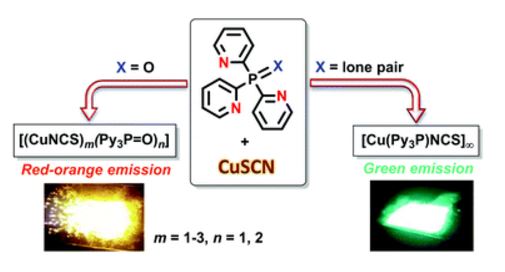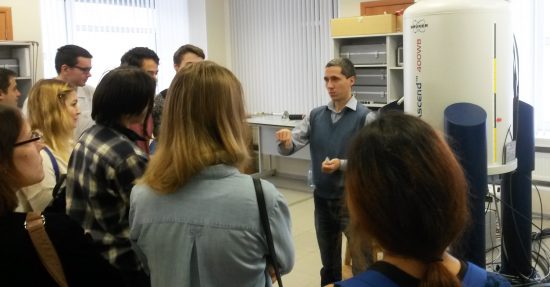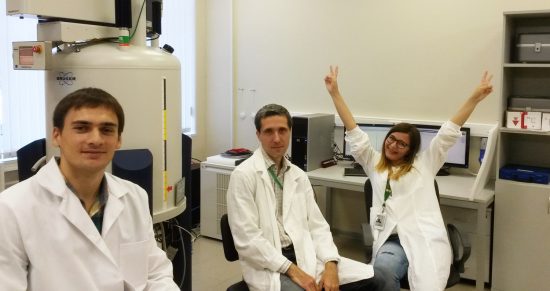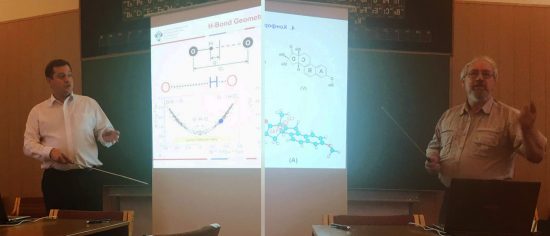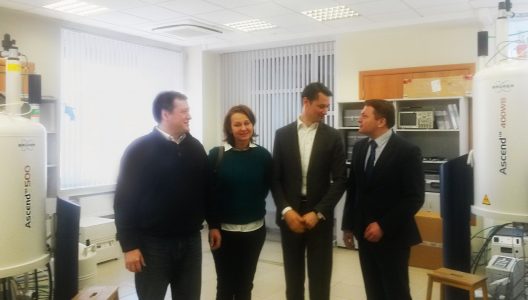
Сегодня в РЦ МРМИ прошла обзорная экскурсия для гостей из Агенства Стратегических Инициатив. В рамках экскурсии проведена демонстрация оборудования, приведены примеры некоторых решаемых задач пользователей РЦ. Обсуждались особености постановки исследовательских задач и пути их решения.
Tag Archive for Толстой
АСИ
Molecules, 2016, 21, 1657-1/19
L. Sobczyk, D. Chudoba, P.M. Tolstoy, A. Filarowski
“Some Brief Notes on Theoretical and Experimental Investigations of Intramolecular Hydrogen Bonding”
Molecules, 2016, 21, 1657-1/19
DOI:10.3390/molecules21121657

A review of selected literature data related to intramolecular hydrogen bonding in ortho-hydroxyaryl Schiff bases, ortho-hydroxyaryl ketones, ortho-hydroxyaryl amides, proton sponges and ortho-hydroxyaryl Mannich bases is presented. The paper reports on the application of experimental spectroscopic measurements (IR and NMR) and quantum-mechanical calculations for investigations of the proton transfer processes, the potential energy curves, tautomeric equilibrium, aromaticity etc. Finally, the equilibrium between the intra- and inter-molecular hydrogen bonds in amides is discussed.
Phys. Chem. Chem. Phys., 2016, accepted
B. Koeppe, S.A. Pylaeva, C. Allolio, D. Sebastiani, E.T.J. Nibbering, G.S. Denisov, H.-H. Limbach, P.M. Tolstoy
“Polar solvent fluctuations drive proton transfer in hydrogen bonded complexes of carboxylic acid with pyridines: NMR, IR and ab initio MD study”
Phys. Chem. Chem. Phys., 2016, accepted
DOI:10.1039/C6CP06677A
We study a series of intermolecular hydrogen-bonded 1 : 1 complexes formed by chloroacetic acid with 19 substituted pyridines and one aliphatic amine dissolved in CD2Cl2 at low temperature by 1H and 13C NMR and FTIR spectroscopy. The hydrogen bond geometries in these complexes vary from molecular (O–H…N) to zwitterionic (O…H–N+) ones, while NMR spectra show the formation of short strong hydrogen bonds in intermediate cases. Analysis of CQO stretching and asymmetric CO2 stretching bands in FTIR spectra
reveal the presence of proton tautomerism. On the basis of these data, we construct the overall proton transfer pathway. In addition to that, we also study by use of ab initio molecular dynamics the complex formed by chloroacetic acid with 2-methylpyridine, surrounded by 71 CD2Cl2 molecules, revealing a dualmaximum distribution of hydrogen bond geometries in solution. The analysis of the calculated trajectory shows that the proton jumps between molecular and zwitterionic forms are indeed driven by dipole–dipole solvent–solute interactions, but the primary cause of the jumps is the formation/breaking of weak CH…O bonds from solvent molecules to oxygen atoms of the carboxylate group.
New J. Chem., 2016, 40, 10028-10040
A.V. Artem’ev, E.P. Doronina, M.I. Rakhmanova, A.O. Sutyrina, I.Yu. Bagryanskaya, P.M. Tolstoy, A.L. Gushchin, A.S. Mazur, N.K. Gusarova, B.A. Trofimov
“Luminescent CuI thiocyanate complexes based on tris(2-pyridyl)phosphine and its oxide: from mono-, di- and trinuclear species to coordination polymer”
New J. Chem., 2016, 40, 10028-10040
DOI:10.1039/C6NJ02087A
Tris(2-pyridyl)phosphine oxide reacts with CuSCN to form a variety of luminescent complexes, depending on the specified metal-to-ligand ratio and the solvent used, viz. mononuclear [Cu(N,N′,N′′-Py3P=O)(NCS)], dinuclear (N,N′-Py3P=O)Cu(SCN NCS)Cu[(N,N′-Py3P=O)], their co-crystal (2 : 1, correspondingly) and trinuclear {Cu(NCS)[SCNCu(N,N′,N′′-Py3P=O)]2}. In the solid state, these complexes feature red-orange emission upon UV photoexcitation. The reaction of tris(2-pyridyl)phosphine with CuSCN quantitatively produces an almost insoluble coordination polymer, [Cu(Py3P)NCS]n, which exhibits bright green emission. The synthesized compounds are the first members of the hitherto unknown family of Cu(I) thiocyanate complexes supported by tripodal ligands.
Экскурсия
Курс спектроскопии ЯМР
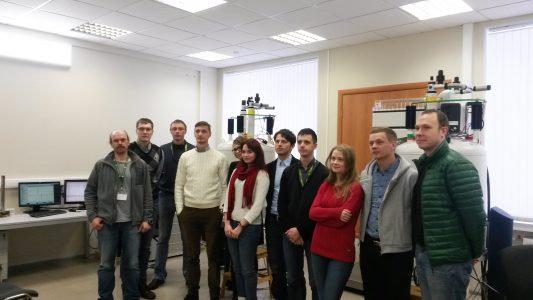
Сегодня в РЦ МРМИ состоялось завершающее занятие серии лекций о современных методах спектроскопии ядерного магнитного резонанса в органической химии, проведенных для сотрудников компании BIOCAD. В ходе занятия была проведена демонстрация работы на современном оборудовании.
Конгресс Университета Арктики
В рамках Конгресса Университета Арктики (12-16.09.2016, Санкт-Петербург; http://www.uarctic.spbu.ru/) П.М. Толстой выступил с докладом о работе Научного парка СПбГУ на примере РЦ «Магнитно-резонансные методы исследования». Был организован телемост с ресурсным центром, во время которого специалисты А.С. Мазур и М.А. Вовк отвечали на вопросы о текущей работе и выполняемых проектах.
Self-Assembly, Dynamics and Structure in Soft Matter Systems
27.06.2016 в Российском химическом обществе прошел семинар «Self-Assembly, Dynamics and Structure in Soft Matter Systems», в котором свои доклады представили, в частности, П.М. Толстой и С.И. Селиванов. В работе семинара принимали участие исследователи из СПбГУ, из университета г. Лилля (Франция) и из института химии растворов РАН (Иваново).
МРТ

Получено первое прямое экспериментальное подтверждение существования головного мозга у директора РЦ МРМИ. С привлечением иностранных специалистов (Dr. Jing Guo, Dr. Benjamin Koeppe), а также бывших сотрудников РЦ Светланы Пылаевой и д-р Андрея Гуринова в клинике Charite (Берлин, Германия) были зарегистрированы слабые сигналы магнитного резонанса от головы П.М. Толстого. Сделанная на их основе реконструкция (см. рисунок) свидетельствует в пользу гипотезы о существовании у пациента головного мозга.
Glass Physics and Chemistry, 2016, 42(3), 230–237
A.A. Osipov, V.E. Eremyashev, A.S. Mazur, P.M. Tolstoi, L.M. Osipova
“Coordination State of Aluminum and Boron in Barium Aluminoborate Glass”
Glass Physics and Chemistry, 2016, 42(3), 230–237
DOI:10.1134/S1087659616030111
This paper considers the coordination state of boron and aluminum ions in barium aluminoborate glass with a constant ratio of BaO : B2O3 = 0.5 and a variable ratio of Al2O3 : BaO = 0–3. The dependence of the concentrations of boron and aluminum atoms with a variable coordination number on the Al2O3 content was estimated by IR, 11B and 27Al NMR spectroscopy. The nonlinear nature of the obtained dependences was attributed to variations in the aluminum oxide properties. At a content of less than 30 mol % Al2O3 serves primarily as a network former, while an increase in the Al2O3 concentration results in its higher modifying role in the studied glass.

